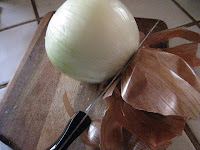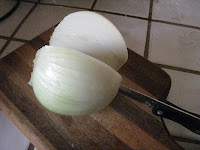It's that time of year again. For many, Thanksgiving is synonymous with roast turkey and stuffing, with lots of pies to follow.
For others, the really mandatory dish at the Thanksgiving day feast is Green Bean Casserole...and please don't try to make any adjustments to the tradition. Since I have been given the task of bringing vegetable sides to this year's dinner, I will be responsible for making the green beans along with some roasted squash and perhaps one more choice.
So how can a "frugal" cook justify spending $15 or more for a pound of the traditional garnish when I just bought onions for 23 cents a pound? Surely these can't be difficult to make...can they?
Off to the search engines to find methods and recipes, a very simple task with over a million hits for "French fried onions recipe." Blog after blog talked about the ease of making these, along with praise for the fresh flavor and lack of preservatives the homemade crisps provided.
I was hooked. I started out with just two onions, but one was large enough that I ended up with over 4 cups of the thinly slivered pieces or "strings," the name given these on a couple of blogs. In the end, I only fried up less than half of them, still ending up with over 12 oz of finished product.
My results? These were pretty easy, though there are some hints that need to be followed to come up with nicely golden and crisp pieces. The time (and dishes to be washed) was not overwhelming but certainly would be a factor in anyone's decision to make from scratch or buy. And the cost (not including the cook's time) would definitely be less. However, as noted below, there are some "leftovers" from the process that would need to be used rather than thrown away or the overall cost could be quite a bit more.
Here is my overall pro and con analysis--review and then decide for yourself if this is something you would want to try.
Pros
Overall cost, based on 38 cents a pound for onions (the "everyday" bottom price here when there are no specials) and current prices for other ingredients, would be a little over a dollar for the 12 ounces I ended up making. Almost all of this cost is coming from the 2 to 3 cups of canola oil that were required. (Under no circumstances would I reuse this!) Part of this low cost also comes from using the remaining milk and flour mixture as noted below.
There are no preservatives and you can adjust for yourself the level of salt used. Many of the recipes on the web suggest soy or other gluten-free flours, and that could easily be done, another plus if you have special diets to consider.
The amount of time it took to make this was relatively short, less than an hour from start to finish--and I was able to do some minor clean up chores around the kitchen while watching (closely!) each batch of strings as they fried. This could also be a fun activity to do with others in the kitchen as well.
These will store well if cooled completely before putting in a tightly sealed (preferably glass) container, so they can be made ahead to have on hand for the holidays. They can be frozen, but should be thawed completely before opening the container.
Cons
I really don't like frying things, and this involves the usual frying mess of thermometers, cookie sheets covered with paper towels, and grease to be disposed of. For me, the yuk factor is pretty high.
If you are not very careful about shaking off excess flour, the oil will quickly darken and even begin to taste burned. I used a strainer to dip out some of this between batches, but it takes some practice to avoid problems with this. If you end up with too much browned matter in the bottom, you might want to start over with new oil, but that adds more dishes (you'll need another pan unless you are ready to wait for the first oil to cool) and added cost of oil.
While less than an hour from start to finish may be "short" for someone with time to spend in the kitchen, trying to squeeze in this chore along with all the other holiday preparation could be just too much to add to the cook's to-do list.
If you don't have time, patience, or desire to use the "leftover" milk and flour mixture, the cost will be quite a bit higher and would certainly bring into question any savings you might have hoped to realize.
Bottom line:
This may be a fun thing to try once or twice and it could even be a good option if you are trying for a gluten free topping. Otherwise, you have three options:
- Convince the traditionalists that they don't need this low-nutrition topping anyway (how about seasoned bread crumbs browned in a little butter with some slivered almonds tossed in instead?)
- Bite the bullet and buy the smallest container you can get away with
- Top the casserole with onions simply sauteed in a little butter and bread crumbs. They might not be as crisp, but the flavor will be at least as good, and the calorie content has to be lower.
French Fried Onion Strings for Toppings
1 large or 2 medium onions, thinly cut in julienne slices--about 2 to 3 cups
2 c milk
2 c flour
2 t salt, or to taste
2 t onion powder (or substitute onion salt for part of regular salt)
canola oil for frying--start with 2 to 3 cups
1. Pour the milk into a flat bowl. Combine the flour, salt, and onion powder in a somewhat larger flat bowl.

2. To prepare the onions, peel and quarter from pole to pole, not across the equator. Thinly slice each quarter into julienned "strings" and put into the milk. Allow to soak at least 5 minutes or so.

3. Spread a layer of newspaper on a large baking sheet and cover with two thicknesses of paper towels. (You will want to have more newspaper and paper towels ready for later batches too.)
4. Pour about 2 inches of oil into a medium pan or skillet and begin heating over medium-high heat. Insert a deep-frying thermometer in the oil (don't allow it to touch the bottom of the pan) and heat the oil to 375 degrees.
5. When the oil is almost ready, take a handful of onion strings from the milk, drain lightly and toss in the flour. Still using your hands, lift and shake the onion strings to get as much excess flour as possible from falling into the oil. Drop the coated strings into the oil all at once (be careful not to let it splash!) and stir lightly. A "handful" was about a cup or so of the coated strings, just the right amount for my pan. Don't try a larger pan. If you add all the onions at the same time, you will have difficulty getting them to cook evenly, so using the smaller pan and doing only a few at a time will yield much better results--and will require less oil overall.
6. Allow the onion strings to brown completely and then lift out with a slotted spoon or strainer. Spread on the prepared paper towels to drain and then wait for the oil to return to 375 degrees before adding the next batch.
While waiting for the oil to heat up, you may want to use your strainer or slotted spoon to lift out some of the browned flour at the bottom of the pan. You may also need to add more oil after a few batches--if so, be very sure to allow the temperature to return to 375 before adding more onions.
When finished, allow the oil to cool completely before disposing.
Now, for the extra milk and flour--and small pieces of onion that are still going to be hiding in that flour mixture--use it to make your own sauce for the green bean casserole or any other "hot dish" application where cream of mushroom soup is called for.
Cream of Mushroom Sauce, with Onions
2 T butter and 1 T canola oil (or all oil)
8 oz fresh mushrooms, cleaned and sliced
1/2 c seasoned flour from fried onions--include onion bits that may be in the flour
1 3/4 to 2 c milk--use "leftover" milk from the fried onions if you have it
1 chicken or vegetarian bouillon cube
salt, seasoning salt, and black pepper to taste
1. Saute the mushrooms in the butter and oil over medium heat. Cook until the mushrooms are golden and tender.
2. Stir in the flour, making a roux--that is, stir the mixture together until it is evenly mixed and the flour has completely"disappeared" into the oils. Continue to cook for a minute or two more.

(Okay, that looks a little scary, doesn't it! Never fear. If you have only the butter/oil mixture and the mushrooms in the pan so far, the flour will blend into the oils in the pan without a problem. Just keep stirring until you can't see any of the white flour. Be brave!)
3. Stir in 1 3/4 cups of the milk, cooking and stirring until the mixture bubbles and thickens. Add additional milk to reach desired thickness. Taste and adjust for seasoning.
The sauce you have just made can be used wherever a recipe calls for condensed cream of mushroom soup. This will make the equivalent of two of the familiar red and white label cans. The onion in the flour (and flavoring the milk as well) provides a subtle boost very like the familiar canned soup flavor, and without any of the preservatives.
Variation:
If you decided not to make your own onion topping, you can still make this mushroom sauce. Just finely dice 1/2 cup or so of onion and saute with the mushrooms.
With both the French-fried onions AND the condensed soup for the sauce ready, now you are ready to put together the "classic"green bean casserole--the really easy part!
Classic Green Bean Casserole
16 oz package frozen green beans--French cut preferred
1 can cream of mushroom soup OR 1/2 recipe from above
1 T Worcestershire OR soy sauce--optional
1 c (or more if you like) French fried onion pieces
Thaw the beans but do not cook. Stir in the mushroom soup, about a third of the onions, and Worcestershire or soy sauce if used. Pour the mixture into a 1 1/2 quart casserole dish and top with the remaining onion pieces.
Bake at 350 degrees about 20 to 25 minutes, until bubbly.
Variation--if fresh beans are used, cook until just tender crisp, drain, and then proceed with the recipe.





















